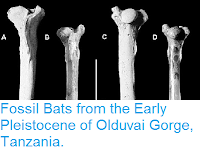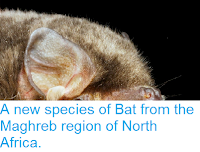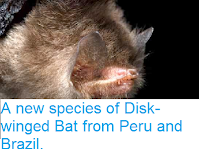Tube-nosed Fruit Bats, Nyctimeninae, are found across the islands of the Pacific from the Philippines to the Solomon Islands. They can be distinguished from other Fruit Bats by their protruding nostrils, spots on their wings and a distinctive pattern of dentition, with no lower incisors, no second premolars on either jaw, and no second premolars on the upper jaw. Twenty one species in two genera are currently described, though the taxonomy of the group is problematic, as many species are highly variable, with overlapping features with other species, and in addition the Bats change considerably over their life-cycles, and sometimes show sexual dimorphism (i.e. the sexes are different). To make this worse, many of the known species are described from poorly preserved museum specimens, often with distinctive features, particularly the teeth, missing. This is a matter of concern, as with a large number of species endemic to small islands, the group is likely to contain many species at risk of extinction, and it is difficult to implement conservation programs without a proper understanding of a group's taxonomy. With this in mind the International Union for the Conservation of Nature's Species Survival Commission Chiroptera Group has recommended surveys of all members of the group across the full extent of their range.
In a paper published in the Records of the Australian Museum on 20 August 2017, Nancy Irwin of the School of Biological Sciences and Veterinary Science Department at the The University of Queensland and the Department of Biology at the University of York, describes a new, cryptic, species of Tube-nosed Fruit Bat from Papua New Guinea.
The new species is placed in the genus Nyctimene, and given the specific name wrightae, in honour of Debra Wright, the former Director of the Wildlife Conservation Foundation's Papua New Guinea program, and co-founder of the Papua New Guinea Research Foundation and Papua New Guinea Institute of Biological Research, for her assistance with work in Papua New Guinea, as well as here long-term capacity building and training of Papuan New Guinean scientists. The species is extremely similar to the previously described Nyctimene certans, and can only be reliably differentiated by genetic analysis. However the new species does, on average, have broader molar teeth than Nyctimene certans, which in turn gives these Bats a wider mouth, so that they appear, to Human eyes, to be smiling, leading to some members of the research team to give the species the English name 'Happy Bat'.
Nyctimene wrightae, female with young pup attached, showing characteristic long ears with thickened edge and short, brown hair. Debra Wright in Irwin (2017).
The new species is apparently extremely widespread in the lowland and montane forests of Papua New Guinea, with all but four of the 123 museum specimens assigned to 'Nyctimene certans' being found to in fact belong to Nyctimene wrightae. As such the species does not appear to face any immediate threat to its survival, though Nyctimene certans appears to be much rarer than previously thought, with only four specimens (all male) present in Museum collections.
Nyctimene wrightae, yellow colour morph with large brown spots caught in O-Pio, Chimbu Province, the dorsal stripe is clear and becomes thinner in upper part of back. Irwin (2017).
See also...
Follow Sciency Thoughts on Facebook.








